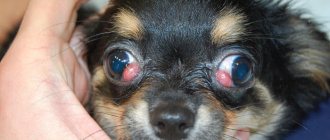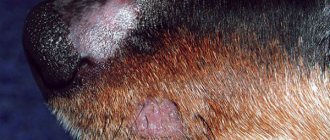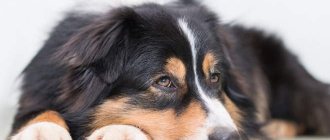Predisposition of cats to hyperthyroidism Symptoms Causes of hyperthyroidism in cats Diagnosis Treatment Prognosis Prevention Hyperthyroidism in cats is a disorder that is characterized by increased synthesis of thyroid hormones and subsequent acceleration of metabolism. The thyroid gland is located in the neck and plays a large role in regulating metabolism in the body. This is a fairly common disease in adult cats. Despite the enlargement of the thyroid gland, this disease is usually benign. A thyroid tumor occurs in less than 2% of cases of feline hyperthyroidism.
This disease affects many organs, including the heart. The heartbeat becomes faster and stronger, which ultimately leads to an enlarged heart. An increased heart rate leads to increased blood output and increased blood pressure. More than 25% of cats with hyperthyroidism have high blood pressure.
Symptoms of hyperthyroidism in cats
The typical cat with hyperthyroidism is a middle-aged or older cat; on average, cats over 12 years of age are affected. Most of them experience weight loss due to increased metabolism. The cat's body tries to compensate for the lack of weight by increasing its appetite. Outwardly, the cat seems constantly hungry and is ready to eat literally everything it sees. Despite their increased appetite, many cats continue to lose weight. Weight loss can occur gradually, without owners realizing it, or it can be rapid. Sick cats drink water often and in small portions, and urination also becomes more frequent. Periodic vomiting or diarrhea may occur, and hair loss may occur. Some cats develop anorexia.
Two secondary complications of this disease are important. These include hypertension (increased blood pressure) and a heart condition called thyrotoxic cardiomyopathy. Hypertension occurs due to increased cardiac output. In some cats, increased blood pressure leads to hemorrhages and retinal detachment, and, as a result, blindness. Heart problems arise due to its expansion and thickening of its wall. Both of these changes are reversible with adequate treatment.
When should you contact a veterinarian?
Pets are at risk of developing hyperthyroidism when they are 12 years of age or older. Sick cats whose metabolism rapidly accelerates, the thyroid gland changes, kidney failure appears, they experience discomfort and constant fatigue.
The main symptoms of hyperthyroidism are:
- increased appetite;
- sudden weight loss;
- increased thirst;
- frequent urination;
- diarrhea (diarrhea);
- vomit;
- matting or hair loss;
- aggression, excessive activity and constant restlessness.
Any suspicion of hyperthyroidism in cats should promptly seek veterinary attention. Otherwise, your pet may develop chronic diarrhea, heart failure, eye or kidney disease. In advanced cases, a sick cat may die.
Treatment of hyperthyroidism in cats
Because malignant degeneration of the thyroid gland is rare, treatment is usually successful. There are three treatment options, the choice of which one depends on the specific case. Many factors are taken into account when choosing treatment for a cat.
Three treatment options:
Oral medications.
Prescribing an oral medication (methimazole) helps control the effects of an overactive thyroid gland. Some cats have a reaction to the medication, but this occurs infrequently (less than 20%). However, side effects may appear even 6 months after the start of treatment, these include vomiting, lethargy, anorexia, fever, anemia (decreased number of red blood cells). Methimazole does not destroy the affected thyroid tissue; rather, it prevents the excessive synthesis of hormones. Therefore, medicine should be given to prolong the life of the cat. To regulate the dosage, it is necessary to periodically conduct blood tests. This treatment is indicated for cats that cannot undergo surgery due to other health problems. Over a period of several weeks, this treatment can also be used to stabilize a cat that is at risk for surgery due to a cardiac complication.
Operative method.
Surgical removal of the affected lobes of the thyroid gland is very effective. Since hyperthyroidism usually affects cats over 8 years of age, there is a certain risk with this treatment. However, if the cat has no other illnesses, the risk is minimal. In most cats, only one lobe of the thyroid gland is affected. Cats requiring surgical treatment are brought to the clinic on the morning of the operation and discharged in the evening.
Radioactive iodine.
There is an additional treatment for hyperthyroidism using radioactive iodine (I131). It is given in injection form and destroys all abnormal thyroid tissue without damaging other organs. Treatment is carried out in a veterinary clinic that has permission to provide radiation therapy, and takes 1-2 weeks. Sometimes, but not always, the cost of this treatment exceeds the cost of other options. This therapy destroys all thyroid tissue, so you should consider all side effects and end results before starting treatment.
If surgery is chosen, the cat is often given oral medications several weeks before surgery. During this time, the appetite normalizes and the animal usually gains weight. Pre-treatment with medication also helps resolve the problem of increased heart rate and high blood pressure. After a few weeks, it is necessary to recheck the levels of kidney indicators and thyroid hormones in the blood.
Recurrence of the disease is possible in some cats, although this is rare after treatment with iodine. After surgery, this phenomenon is possible if abnormal thyroid cells still remain in the cat's body. These cells begin to divide, causing the disease to return. But this happens only in 5% of cases and usually 2-4 years after surgery. Another possibility is that lobes of the thyroid gland that appeared normal were not removed during surgery. Subsequently, months or years later, they become abnormal.
Symptoms
Thyroid hormones, produced in large quantities, can have a negative effect on almost all organs of the animal. However, in some cats hyperthyroidism manifests itself with one or two signs, while in others the disease has a multifaceted symptomatic picture.
The pathology in question develops gradually, which can mislead the animal owner: many people mistakenly associate weight loss and dull fur with the natural aging of their pet, and are in no hurry to show it to the veterinarian.
Stomatitis
Rickets
Haemorrhoids
Since the disease most often affects animals over 8 years of age, it is important to carefully monitor the health of older cats. You can tell that your pet has problems with the thyroid gland by the following signs:
- Weight loss and sometimes extreme exhaustion.
- Thirst, excessive appetite.
- Increased number of urinations.
- Periodic occurrence of vomiting and diarrhea.
- Rapid heartbeat, shortness of breath.
- Lethargy, irritability.
Half of the patients experience skin damage, manifested in the form of:
- Oily seborrhea.
- Spontaneous hair loss.
- Hair matting (this symptom is more pronounced in long-haired animals).
- Baldness on the sides resulting from excessive licking.
- Acceleration of claw growth.
If you detect at least a few symptoms of hyperthyroidism in a cat, you should not attribute them to natural aging. A timely visit to the veterinarian will help start treatment on time and prevent the development of complications dangerous to the cat’s health.
Diagnosis of the disease
Hyperthyroidism in cats and dogs manifests itself in the same way as chronic renal failure, liver disease or neoplasia. These pathological conditions must be excluded during diagnosis of the animal's condition. Examination of a cat or dog should include:
- carrying out general analysis and blood biochemistry;
- determination of thyroid hormone levels (total T4);
- urine test.
In some cases, chest X-ray, ECG, and coprogram are indicated.
When receiving the result from a general blood test, there is no change in the number of red blood cells or hematocrit. A fifth of animals exhibit macrocytosis. A significant concentration of thyroid hormones promotes the release of a significant amount of erythropoietin, which, in turn, increases macroerythrocytes. You can also identify a condition that is characterized as a stress leukogram.
Analyzing the biochemical blood test, the high activity of liver enzymes and alkaline phosphatase is striking. However, these changes are characterized as insignificant. If deviations from the norm are significant, concomitant diseases must be taken into account. When examining electrolytes, in most cases no negative changes are observed. Hyperthyroidism is also often accompanied by an increase in the concentration of urea and creatinine.
In most cases, to make an accurate diagnosis, it is enough just to determine the level of thyroxine in the animal’s blood. The presence of the disease is indicated by an increase in the concentration of this hormone. If, after the analysis, indicators are identified that are at the upper limit of normal, it is necessary to repeat the study after 2-6 weeks. This result may indicate the presence of concomitant pathologies.
Feline hyperthyroidism
Feline hyperthyroidism
More common in older cats. Hyperthyroidism in dogs is very rare, mainly due to neoplasms of the thyroid gland. There is no breed or gender predisposition to the disease.
The hormones thyroxine and triiodothyronine regulate oxidative processes in the body, affect all types of metabolism and enzymatic processes. They contain iodine. Thyroid calcitonin, counteracting parathyroid hormone, reduces calcium levels in the blood. The thyroid gland also influences tissue growth, development, and differentiation.
Most often, the disease is caused by the formation of benign, actively functioning foci of the thyroid gland (adenomas), which secrete excess amounts of hormones. Several adenomas can form in one lobe, and in approximately 70% of cases, they form in both lobes. At the same time, the gland increases in volume and has the appearance of a “bunch of grapes”.
Malignant lesions (adenocarcinoma) of the thyroid gland, as a cause of hyperthyroidism in cats, are quite rare (less than 2%).
How does it manifest?
Thyroid hormones affect the functioning of many body systems and, therefore, with hyperthyroidism, clinical signs can vary greatly.
- Hyperactivity, nervousness
- Loss of body weight with preserved or increased appetite
- Cardiac and respiratory disorders (tachycardia, cough, dyspnea)
- Tremor
- Vomit
- Diarrhea
- Polyuria, polydipsia
- Deterioration in wool quality
- Periods of anorexia
- Hematuria
- Heat intolerance
- Intermittent low-grade fever
- Apathy, depression (approximately 10% of patients)
- Respiratory pathologies
- Exhaustion
- Deterioration in wool quality
- Enlarged thyroid gland (in 70-80% of cases)
Many symptoms of hyperthyroidism can be observed in other diseases, such as diabetes, kidney failure, heart disease, liver disease, and neoplasms.
How to make a diagnosis?
The following diagnostic tests should be performed in animals suspected of having hyperthyroidism:
As a rule, changes in the general blood test are not pronounced; slight erythrocytosis, an increase in hematocrit and hemoglobin, and a stress leukogram (reaction to stress caused by an increase in T3 and T4) may be observed.
Changes in biochemical parameters: there is often a slight increase in liver enzymes, a slight increase in uremia markers, possibly a slight (stress) increase in glucose levels, and sometimes hypokalemia.
How to treat?
Treatment is carried out on an outpatient basis. Due to high metabolism, the diet should be adjusted: provide sufficient protein, increase the intake of highly digestible, high-calorie food with a limited amount of iodine.
There are currently three treatment options:
Proper nutrition, constant monitoring of health, medical examinations will help you take action and, if necessary, begin timely treatment.
Description of the disease
Under the influence of this hormone, the cat develops:
- low weight;
- increased appetite;
- excessive thirst;
- frequent and copious urination;
- increased activity and irritability;
- hair loss;
- dyspnea;
- diarrhea;
- vomit;
- craving for a cold place;
- hard breath.
The formation of these symptoms is influenced by an increased level of the hormone T4 in the blood.
Treatment and prognosis
In the treatment of hyperthyroidism, both surgical and conservative techniques are used.
Surgical intervention
Quite often, specialists resort to surgical excision of one of the lobes of the thyroid gland. This method is simple. The cost of surgery is quite low.
Surgery is necessary if the pet has a benign or malignant tumor.
If the operation is successful, the animal recovers quite quickly.
Drug treatment
In the presence of hyperthyroidism, medications are used that are designed to block the production of thyroid hormones.
These medications include:
- Carbimazole;
- Metamizole;
- Thiamazole.
When using such medications, your pet may experience side effects such as nausea, loss of appetite, allergic rash, and vomiting.
In some cases, when using such drugs, the blood formula changes. But during the first two weeks of treatment, the pet’s condition usually stabilizes.
If well tolerated, drugs used to block the production of thyroid hormones can be used for life.
Metamizole may be prescribed before surgery. The drug reduces the likelihood of complications. The product is given to the cat twice a day. In some cases, Metamizole, made in the form of a gel, is prescribed. The drug may cause vomiting and liver dysfunction.
Popular Why does a cat vomit foam?
Radioiodine therapy
If thyroid function deteriorates, radioactive iodine therapy may be performed. In this case, radioactive iodine is injected into the pet's body. When performing subcutaneous injections, the active substance of the corresponding drugs enters the bloodstream and penetrates the affected organ. As a result, the functioning of a malfunctioning part of the organ is inhibited. The main benefits of iodine treatment are:
- benign neoplasms are eliminated with a single procedure; lack of anesthesia;
- minimal number of side effects;
- no need to take medications, the reaction to which can be unpredictable.
Radioactive iodine therapy is not currently widely used. This is mainly due to the fact that after treatment the animal must be isolated for 10 days. During this period, the radioactivity of the pet manages to decrease to normal values.
In addition, in 3% of cases one injection is not enough to cure the disease. Then there is a need to reappear the procedure.











